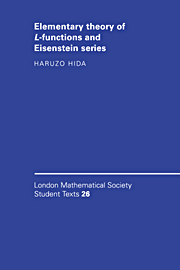Book contents
- Frontmatter
- Contents
- Preface
- Suggestions to the reader
- Chapter 1 Algebraic number theory
- Chapter 2 Classical L-functions and Eisenstein series
- Chapter 3 p-adic Hecke L-functions
- Chapter 4 Homological interpretation
- Chapter 5 Elliptic modular forms and their L-functions
- Chapter 6 Modular forms and cohomology groups
- Chapter 7 Ordinary Λ-adic forms, two variable p-adic Rankin products and Galois representations
- Chapter 8 Functional equations of Hecke L-functions
- Chapter 9 Adelic Eisenstein series and Rankin products
- Chapter 10 Three variable p-adic Rankin products
- Appendix Summary of homology and cohomology theory
- References
- Answers to selected exercises
- Index
Chapter 8 - Functional equations of Hecke L-functions
Published online by Cambridge University Press: 12 April 2010
- Frontmatter
- Contents
- Preface
- Suggestions to the reader
- Chapter 1 Algebraic number theory
- Chapter 2 Classical L-functions and Eisenstein series
- Chapter 3 p-adic Hecke L-functions
- Chapter 4 Homological interpretation
- Chapter 5 Elliptic modular forms and their L-functions
- Chapter 6 Modular forms and cohomology groups
- Chapter 7 Ordinary Λ-adic forms, two variable p-adic Rankin products and Galois representations
- Chapter 8 Functional equations of Hecke L-functions
- Chapter 9 Adelic Eisenstein series and Rankin products
- Chapter 10 Three variable p-adic Rankin products
- Appendix Summary of homology and cohomology theory
- References
- Answers to selected exercises
- Index
Summary
In this chapter, after giving a brief summary of the notion of adeles of number fields, we prove the functional equations of Hecke L-functions. For further study of adeles and class field theory, we recommend [W1] and [N].
Adelic interpretation of algebraic number theory
Let us start with the explanation of the adele ring of Q denoted by A. To define the topological ring A, we consider the module Q/Z and its ring End(Q/Z) of additive endomorphisms. Let Q/Z[p∞] be the subgroup of Q/Z consisting of elements killed by some power of p for a prime p of Z. Then by definition, for any two distinct primes p and q, Q/Z[p∞]∩Q/Z[q∞] = {0} and hence ⊗pQ/Z[p∞] ⊂ Q/Z. Let us show that this inclusion is in fact surjective. For any given rational number r, we expand r into the standard p-adic expansion ∑∞n=-m cnpn defined in §1.3 and put [r]p = ∑-1n=-mcnpn (the p-fraction part). Since r-[r]p ∈ Zp∩Q, p does not appear in the denominator of r-[r]p. Repeating this process of taking out the p-fraction part from r for all prime factors of the denominator of r, we know that r-∑p[r]p ∈ Z and hence r = ∑p[r]p in Q/Z. Since [r]p ∈ Q/Z[p∞], we know that ⊗PQ/Z[p∞] = Q/Z. The above process can be applied to p-adic numbers r ∈ Qp. Then r ↦ [r]p plainly induces an isomorphism: Qp/Zp ≅ Q/Z[p∞].
- Type
- Chapter
- Information
- Elementary Theory of L-functions and Eisenstein Series , pp. 239 - 271Publisher: Cambridge University PressPrint publication year: 1993

